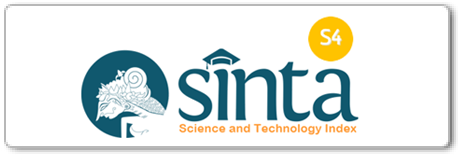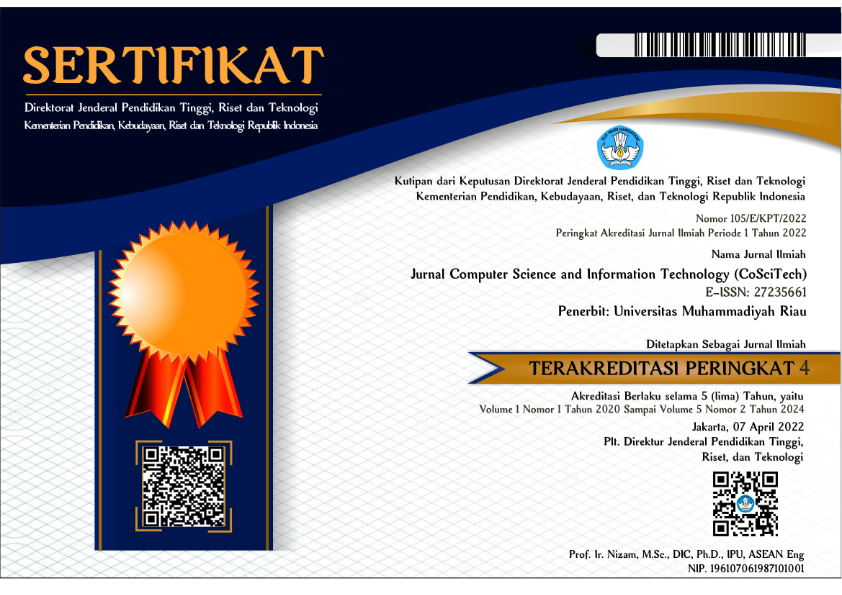Visualizing twitter data into a graph for social network analysis
DOI:
 https://doi.org/10.37859/coscitech.v4i3.5722
https://doi.org/10.37859/coscitech.v4i3.5722
Abstract
Twitter is one of the most widely used social media in Indonesia. As a form of social media, Twitter is widely used to express opinions/opinions, discuss specific issues, convey complaints or sentiments about a product, and political communication. Twitter user communication data can be processed into useful information for various purposes, so we need a way to process Twitter data. The development of information technology makes it possible to multiply this information so that it becomes valuable information. For example, Twitter data can be helpful for companies to profile consumers so that they can improve marketing efforts. In the political field, Twitter data can be used to find people who influence Twitter who can be used to assist the campaign process. In the legal area, this Twitter data can help analyze networks and the distribution of information related to hate speech and hoaxes. To analyze Twitter data, we need to convert it into a data graph to be explored further. Twitter data visualization into data graphs is done because there are differences in data formats. Twitter data is in the form of string data consisting of tweets reflecting user communication. The data graph is a collection of vertices and edges, denoted as Vertex represents Twitter users, and Edge represents user relationships or communication. This study aims to form a data graph based on Twitter data to facilitate the analysis of Twitter data for various interests.
Downloads
References
[2] T. Webster, “Twitter usage in America: 2010,” 2010. [Online]. Available: http://www.edisonresearch.com/twitter_usage_in_america_2010_1/.
[3] “Twitter Usage Statistics-Internet Live Stats,” 2017. www.internetlivestats.com/twitter-statistics.
[4] Alexa, “Alexa Top Sites,” 2019. .
[5] L. Mandloi and R. Patel, “Twitter Sentiments Analysis Using Machine Learninig Methods,” 2020, doi: 10.1109/INCET49848.2020.9154183.
[6] I. Annamoradnejad and J. Habibi, “A Comprehensive Analysis of Twitter Trending Topics,” in 2019 5th International Conference on Web Research, ICWR 2019, 2019, pp. 22–27, doi: 10.1109/ICWR.2019.8765252.
[7] M. Jaouadi and L. Ben Romdhane, “Influence maximization problem in social networks: An overview,” 2019, doi: 10.1109/AICCSA47632.2019.9035366.
[8] G. Enli, “Twitter as arena for the authentic outsider: exploring the social media campaigns of Trump and Clinton in the 2016 US presidential election,” Eur. J. Commun, 2017.
[9] M. Ibrahim, O. Abdillah, A. Wicaksono, and M. Adriani, “Buzzer Detection and Sentiment Analysis for Predicting Presidential Election Results in A Twitter Nation,” 2015.
[10] J. Wu, C. Zhang, Z. Liu, E. Zhang, S. Wilson, and C. Zhang, “GraphBERT: Bridging Graph and Text for Malicious Behavior Detection on Social Media,” in Proceedings - IEEE International Conference on Data Mining, ICDM, 2022, vol. 2022-Novem, no. Icdm, pp. 548–557, doi: 10.1109/ICDM54844.2022.00065.
[11] P. Harjule, A. Gurjar, H. Seth, and P. Thakur, “Text Classification on Twitter Data,” in Proceedings of 3rd International Conference on Emerging Technologies in Computer Engineering: Machine Learning and Internet of Things, ICETCE 2020, 2020, no. February, pp. 160–164, doi: 10.1109/ICETCE48199.2020.9091774.
[12] T. Febriana and A. Budiarto, “Twitter Dataset for Hate Speech and Cyberbullying Detection in Indonesian Language,” in Proceedings of 2019 International Conference on Information Management and Technology, ICIMTech 2019, 2019, vol. 1, no. August, pp. 379–382, doi: 10.1109/ICIMTech.2019.8843722.
[13] B. Wu, X. Yao, and B. Zhang, “Semi-supervised Community Detection using Graph Embedding,” in Proceedings - 2022 IEEE International Conference on e-Business Engineering, ICEBE 2022, 2022, pp. 141–147, doi: 10.1109/ICEBE55470.2022.00033.
[14] N. Alduaiji and A. Datta, “An empirical study on sentiments in twitter communities,” in IEEE International Conference on Data Mining Workshops, ICDMW, 2019, vol. 2018-Novem, pp. 1166–1172, doi: 10.1109/ICDMW.2018.00167.
[15] S. Jain and A. Sinha, “Identification of influential users on Twitter: A novel weighted correlated influence measure for Covid-19,” Chaos, Solitons and Fractals, vol. 139, p. 110037, 2020, doi: 10.1016/j.chaos.2020.110037.
[16] N. Saxena and V. Agarwal, “Learning to Detect: A Semi Supervised Multi-relational Graph Convolutional Network for Uncovering Key Actors on Hackforums,” Proceedings - 2021 IEEE International Conference on Big Data, Big Data 2021. IEEE, pp. 2550–2559, 2021, doi: 10.1109/BigData52589.2021.9671446.
[17] Z. A. Rachman, W. Maharani, and Adiwijaya, “The analysis and implementation of degree centrality in weighted graph in Social Network Analysis,” in 2013 International Conference of Information and Communication Technology, ICoICT 2013, 2013, pp. 72–76, doi: 10.1109/ICoICT.2013.6574552.
[18] M. Hrishiah, M. Safar, and K. Mahdi, “Modeling Twitter as weighted complex networks using retweets,” in Proceedings of the 2016 IEEE/ACM International Conference on Advances in Social Networks Analysis and Mining, ASONAM 2016, 2016, pp. 701–702, doi: 10.1109/ASONAM.2016.7752313.
[19] P. E. Nalwoga Lutu, “Using twitter mentions and a graph database to analyse social network centrality,” in 2019 6th International Conference on Soft Computing and Machine Intelligence, ISCMI 2019, 2019, pp. 155–159, doi: 10.1109/ISCMI47871.2019.9004313.
[20] A. Yonatan, “Instagram vs Twitter: Mana Pilihan Penduduk Dunia?,” 2023. https://goodstats.id/article/instagram-vs-twitter-mana-pilihan-penduduk-dunia-JauAH.
[21] V. S. Martha, W. Zhao, and X. Xu, “A study on Twitter user-follower network: A network based analysis,” in Proceedings of the 2013 IEEE/ACM International Conference on Advances in Social Networks Analysis and Mining, ASONAM 2013, 2013, pp. 1405–1409, doi: 10.1145/2492517.2500298.
[22] D. Boyd, S. Golder, and G. Lotan, “Tweet, tweet, retweet: Conversational aspects of retweeting on twitter,” in Proceedings of the Annual Hawaii International Conference on System Sciences, 2010, pp. 1–10, doi: 10.1109/HICSS.2010.412.
[23] F. K. Dewi, S. B. Yudhoatmojo, and I. Budi, “Identification of opinion leader on rumor spreading in online social network Twitter using edge weighting and centrality measure weighting,” in 2017 12th International Conference on Digital Information Management, ICDIM 2017, 2017, no. Icdim, pp. 313–318, doi: 10.1109/ICDIM.2017.8244680.
[24] F. K. Dewi, S. B. Yudhoatmojo, and I. Budi, “Identification of Opinion Leader on Rumor Spreading in Online Social Network Twitter Using Edge Weighting and Centrality Measure Weighting,” in The Twelfth Interrnational Conference on Digital Information Management, 2017, pp. 243–248, doi: 10.1109/ICACSIS.2013.6761583.
[25] N. Deo, Graph theory with applications to engineering and computer science. Prentice-Hall, 1974.
[26] S. P. Singh and C. K. Leung, “A Theoretical Approach for Discovery of Friends from Directed Social Graphs,” in Proceedings of the 2020 IEEE/ACM International Conference on Advances in Social Networks Analysis and Mining, ASONAM 2020, 2020, pp. 697–701, doi: 10.1109/ASONAM49781.2020.9381341.














